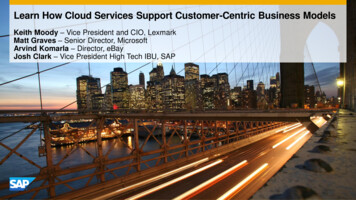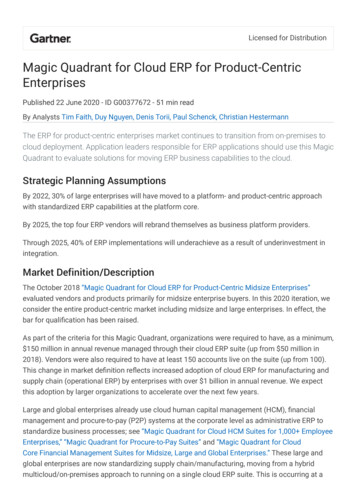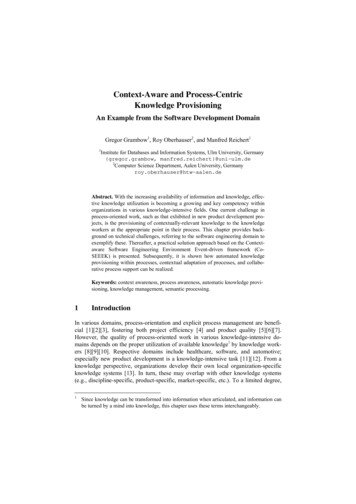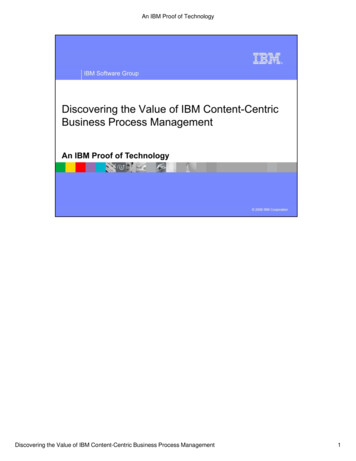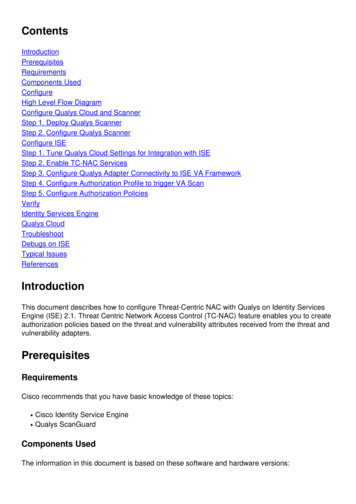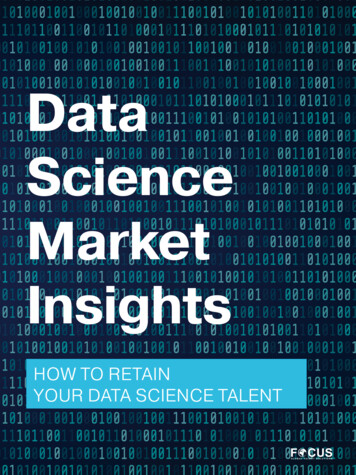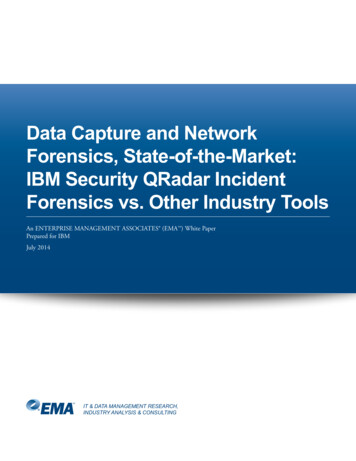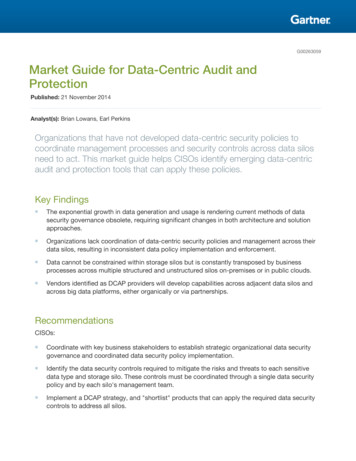
Transcription
G00263059Market Guide for Data-Centric Audit andProtectionPublished: 21 November 2014Analyst(s): Brian Lowans, Earl PerkinsOrganizations that have not developed data-centric security policies tocoordinate management processes and security controls across data silosneed to act. This market guide helps CISOs identify emerging data-centricaudit and protection tools that can apply these policies.Key Findings The exponential growth in data generation and usage is rendering current methods of datasecurity governance obsolete, requiring significant changes in both architecture and solutionapproaches. Organizations lack coordination of data-centric security policies and management across theirdata silos, resulting in inconsistent data policy implementation and enforcement. Data cannot be constrained within storage silos but is constantly transposed by businessprocesses across multiple structured and unstructured silos on-premises or in public clouds. Vendors identified as DCAP providers will develop capabilities across adjacent data silos andacross big data platforms, either organically or via partnerships.RecommendationsCISOs: Coordinate with key business stakeholders to establish strategic organizational data securitygovernance and coordinated data security policy implementation. Identify the data security controls required to mitigate the risks and threats to each sensitivedata type and storage silo. These controls must be coordinated through a single data securitypolicy and by each silo's management team. Implement a DCAP strategy, and "shortlist" products that can apply the required data securitycontrols to address all silos.
Strategic Planning AssumptionBy 2018, data-centric audit and protection strategies will replace disparate siloed data securitygovernance approaches in 25% of large enterprises, up from less than 5% today.Market DefinitionA DCAP product is characterized by the ability to centrally manage data security policies acrossunstructured, semistructured and structured repositories or silos. The policy will encompasssecurity controls such as the ability to classify sensitive data and control access by centrallymanaging privileges, activity monitoring and data protection. Data protection techniques such asencryption, tokenization and masking can be used selectively to enhance the segregation of dutiesagainst both application users and highly privileged users. The ability to offer auditing and reportingcan also support various compliance requirements.Data classification and discovery are also core requirements for content-aware data loss prevention(DLP) tools (see "Magic Quadrant for Content-Aware Data Loss Prevention"). DLP is focused onprotecting data in motion through the prevention of data leakage outside of the organization.However, DCAP is primarily focused on using data classification and discovery to help with theprotection and activity monitoring of data at rest and in use within the organization.DCAP products support several additional capabilities that include: Provide a single management console that enables the application of data security policyacross multiple data repository formats (referred to here as data silos). Classify and discover sensitive data across relational database management systems (RDBMS)or data warehouses, unstructured data file formats, semistructured formats such as SharePoint,semistructured big data platforms such as Hadoop, and cloud-based file stores. Set, monitor and control privileges of unique user identities (including highly privileged userssuch as administrators and developers) with access to the data. Monitor user activity with customizable security alerts. Create auditable reports of data access and security events with customizable details that canaddress defined regulations or standard audit process requirements. Prevent specific data access by individual users and administrators. This may also be achievedthrough encryption, tokenization, masking or redaction.Market DirectionThe advent of big data platforms and cloud-based enterprise file-sharing services (EFSS) is drivingorganizations to review their strategy for data security. Traditional approaches are limited to datasilos because the manner in which vendor products address policy is siloed, and thus the1organizational data security policies themselves are siloed. For example, the approach toPage 2 of 13Gartner, Inc. G00263059
structured database security governance is frequently different from the approach taken forunstructured or semistructured data in an organization. Transposing data from one silo to anothercreates an interrelated data processing environment that lacks synchronization of security policyand leads to security chaos because organizations have not developed processes to deal with it.This leaves organizations open to internal malpractice, hacking, data breaches and financialliabilities.Organizations must develop a comprehensive policy — based on data security governanceprinciples — to apply appropriate security controls across all data silos. This often requires thepurchase of more than one DCAP product to match the targeted silos and the development ofmanagement structures that coordinate and align data security policy and accountability acrossthose silos (see "Big Data Needs a Data-Centric Security Focus").The DCAP market is in the earliest stages of development, and only a few of the vendors selectedare beginning to address all, or only a few, of the siloes. Therefore, the market is currentlycharacterized with most of the vendors focused on specific data silos such as databases,unstructured file stores and cloud. Current Gartner research refers to four major solution sets:database audit and protection (DAP), data access governance (DAG), cloud access security broker(CASB), and data protection (DP), including encryption, tokenization and data masking. In the nearterm, all of these vendors will develop capabilities across adjacent silos and across big dataplatforms, either organically or via partnerships. A number of vendors have also emerged to supportcloud-based EFSS, but they lack support for on-premises data silos. Some DP vendors haverecently emerged with tools that operate across multiple silos, with capabilities for privilegemanagement, activity monitoring, security alerting and audit.Vendor CategoriesWhile no individual products fully meet the requirements of a DCAP product, there are currently fourmain categories of products that in aggregate comprise DCAP capabilities across the data silos: DAP — These products have developed over several years to cover implementation of datasecurity policy, data classification and discovery, access privilege management, activitymonitoring, audit and data protection. Focused on RDBMS and data warehouses, a fewvendors are beginning to offer support for Hadoop and unstructured file shares. DAG — Typically, these products are focused on implementation of data security policy, dataclassification and discovery, activity monitoring and audit of unstructured data within file sharessuch as SharePoint and various file stores. These vendors are closely tied to identity andaccess management vendors. DCAP candidates are also beginning to develop capabilities forHadoop. CASB — The ability of organizations to protect data within cloud storage environments such assalesforce.com, ServiceNow, Box and Dropbox has only started to become a reality within thelast 18 months through a few recent startups. Data classification and discovery, access controlsand activity monitoring are still developing.Gartner, Inc. G00263059Page 3 of 13
DP — These products have developed capabilities to protect data using encryption,tokenization or masking across multiple data silos (RDBMS, data warehouses, unstructured, bigdata and some cloud-based EFSSs). In addition, some activity monitoring and audit capabilitiesare being developed. Whereas DAP and DAG products may offer monitoring of access to alldata within files or databases, these DP products are typically focused upon sensitive datatypes only.Future Market DirectionThe DCAP market will be very different by the end of 2018, with repositioned and morecomprehensive product offerings. Several vendors will offer full DCAP products, covering all of thediscussed data silos, while many of the other vendors will continue their organic development ofcapabilities in terms of breadth and depth across multiple silos. Compliance requirements and theadvent of big data are forcing CISOs to apply their strategy across silos. This is pushing vendors toinnovate through cross-siloed product offerings, which in turn are changing the dynamics andattractiveness of separate market segments into one larger market. This market will see newentrants and consolidation through mergers, acquisitions and some failures. Most of the vendors will offer centralized management platforms that can directly control datasecurity policies across multiple data silos. Competition between vendors will intensify through support for Hadoop and other big dataplatforms and integration with policy enforcement functionality across multiple platforms. DP vendors will, through a necessity to compete, continue to diversify product offerings withdeeper activity monitoring and privilege management capabilities. Likewise, more vendors willeither directly integrate their own data protection functionality within the management consoleor will develop functionality where it is lacking. Products will be driven to address multinational data residency and compliance issues throughthe application and management of on-premises data protection and privilege management tocontrol access. The cloud will become a new battleground for product differentiation, with potential foracquisitions, mergers and new entrants.Innovation and product diversification will intensify, especially as DAP and DAG product capabilitiesconverge toward Hadoop. Mergers and acquisitions across these silos will inevitably develop as ameans to plug product gaps and as new entrants emerge.Market AnalysisThe four market segments that contribute to DCAP have evolved over vastly different timescaleswith different security focal points and business drivers. Convergence of product capabilities towardHadoop, from vendors previously focused on database and unstructured files, has created a surgein interest toward a much larger market opportunity through the combined segments. Convergenceof these adjacent markets is driving current organic developments but has also attracted newPage 4 of 13Gartner, Inc. G00263059
entrants from the DP market. Imperva has acquired a cloud-based CASB vendor, which will open anew market direction and will also create exposure to existing CASB vendors that have beendeveloping data protection and activity monitoring functions.Most vendors have developed a common need to classify and discover data, manage and monitoraccess, provide auditable reports and provide some form of protection (see Figure 1). However,these capabilities are not created equal, and care should always be taken to address productrequirements based on data security governance principles and the controls available throughimplementation of data security policies of the selected product or products.Figure 1. Summary of the Core DCAP Capabilities Offered by Vendors in Each SegmentData SecurityPolicyMonitoringProtectionData Classificationand DiscoveryMonitoring of UserPrivileges and ActivityEvent Detection,Analysis and AlertingData Security PolicyManagementAuditing and ReportingEncryption,Tokenization and DataMaskingSource: Gartner (November 2014)A vendor's ability to integrate these capabilities across multiple silos will vary between products andalso in comparison with vendors in each market segment. Here is a summary of some key featuresto investigate:Data Classification and Discovery — Many products come with built-in dictionaries or searchalgorithms tailored for use with some compliance regimes, but the search capabilities of differentproducts will vary, for example, in terms of speed and false-positive performance. The ability tosearch within a specific RDBMS, file type, Hadoop or cloud EFSS will vary from vendor to vendor. Ifyou are planning to use with RDBMS silos, note that some products may only search column/tablemetadata or within fields. Also check if data can be searched within a binary large object (BLOB) orcharacter large object (CLOB) that may be stored within the database.Data Security Policy Management — The ability to offer a single management console thatcontrols policy across each silo is the desirable goal, and this will evolve as vendors encompassmore silos. Most products will split this functionality, or separate vendor products will be required.In either case, separate software interfaces or separate management consoles will be required.Coordination of roles and responsibilities against the underpinning data security governance will beGartner, Inc. G00263059Page 5 of 13
important. The application of policy is typically based on user identities and business roles asauthenticated through third-party solutions such as active directory (AD) or LDAP. Membership ofgroups can help define access to particular data within a silo, or even multiple groups whengranting access to multiple silos. The ability to identify individual users at the application level canbe a differentiator if applications use connection pooling to provide a more efficient group accessaccount. This can sometimes be enabled by communication with the application through third-partyinterfaces such as Kerberos, but not all applications provide this capability. Other solutions may useapplication layer agents to gather identities.Monitoring User Privileges and Activity — The access rules set out by the data security policy area crucial guide for monitoring the privileges granted to all users with access to the data. This isimportant for checking for changes to AD membership or individual privileges to ensure they matchrequirements associated with business role, data type or geographic location. The ability to detectchanges and create alerts for privilege escalation or changes to data is important to detect potentialinsider abuse or external hacking activities. However, not all products operate at the storage level,and they may not offer the ability to assess the privileges of highly privileged users such asdatabase administrators, system administrators or developers. Monitoring application users andhighly privileged users is important for compliance and is a critical analysis capability to detectinsider misuse or hacking. Therefore, it may be important for a product to be able to interceptaccess by various administrators at the server level. Products need to demonstrate continuousoperation during peak loading of servers or network communications congestion. Considerationmust be given to the network architecture and demands required of products if intensive monitoringis required while infrastructure is highly loaded. This can lead to latency or, in extreme cases, evenfailure to monitor some activity.Auditing and Reporting — As the data silo analysis requirements continue to grow, the demandson the reporting capabilities will grow also. Auditors in various regulatory environments will requirean ability to produce insights into the activity of users on a historical basis, which can require up toone month of accessible data. Compliance will also require an audit trail of various monitoringcapabilities, such as unusual user behaviors, changes to data, policy violations or changes toprivileges.Event Collection Analysis and Reporting — An ability to create security alerts based uponpreselected monitoring criteria is critical, and these might encompass different levels of alert thatrange from policy violations to levels of suspicious behavior. Mechanisms for alerting includeconsole displays and automatic messaging to key security or business staff. Other functionality maybe enabled such as automatic blocking of a process or removal of privileges. Extreme responsesmight include shutting down all access in the event of very large data downloads. Future productsmay even correlate rules to detect unusual behaviors. Products vary in the ease of use of themanagement console interfaces to manage and report security alerts, and the granularity ofreporting within the different data storage platforms. For example, in relation to databases, theremay need to be a trade-off between the number of commands that can be inspected against theability of software/hardware technology to process and communicate the results for analysis. Thiscan happen if servers or network communications are already heavily loaded and the ability of localmonitoring agents to process the large volume of commands is then constrained. Data access canbe blocked based upon data content and group membership or privileges.Page 6 of 13Gartner, Inc. G00263059
Data Protection — Some vendors offer separate data protection tools using encryption,tokenization or data masking, while others do not offer any tools and will require the purchase ofseparate vendor products. In either case, these protection products will not be integrated into asingle management console and will require careful coordination with data security policies. Theselection of these tools requires careful assessment of the threats and risks that each can offer. Forexample, implementing transparent database-level encryption can prevent access by systemadministrators, but DBAs would still have access. Applying dynamic data masking through an agenton the database server, and linked via AD, can be used to prevent access by DBAs. But, since thedata is not protected when stored at rest, it may still be accessible by system administrators.Encrypting or tokenizing fields can protect the data elements in use and at rest, but care must betaken that this does not affect the operation of applications.Representative VendorsThe vendors listed in this Market Guide do not imply an exhaustive list. This section is intended toprovide more understanding of the market and its offerings.The DCAP market is characterized by three primary sets of vendors that have focused on particularsilos but may already be demonstrating or planning coverage of adjacent silos that include RDBMS,unstructured file stores (files), semistructured environments such as SharePoint and Hadoop, andcloud-based file stores (EFSS). Some innovative DP vendors are developing a centralizedmanagement console approach across multiple silos but lack comprehensive DCAP capabilities. Arepresentative mapping is shown in Figure 2, but note that none of these vendors can currently beassessed as yet offering a complete DCAP solution.Gartner, Inc. G00263059Page 7 of 13
Figure 2. Schematic Representation of the DCAP Market Showing How a Sample of Vendors Operates AcrossDifferent Data SilosDetection tools may be applicable across multiple silos through a single management console but other functionality is limited.Source: Gartner (November 2014)Figure 3 shows a sample list of contenders to be identified as potential DCAP vendors. Thesevendors are categorized by the main capabilities outlined in this research (see the Market Analysissection), including: Capabilities for each of the data silos — RDBMS, file stores, big data and EFSS. Each vendorhas a different coverage of these silos through on-premises products. Tools for data classification and discovery. Management of privileges such as read/write or access to classified data types. Privilegemanagement of individual users may not always be possible at the application level. Someproducts focus on only classified data types. Activity monitoring of users and administrators — this may be limited to monitoring access tocertain classified data types. Audit and reporting capabilities typically focused around specific compliance
(DLP) tools (see "Magic Quadrant for Content-Aware Data Loss Prevention"). DLP is focused on protecting data in motion through the prevention of data leakage outside of the organization. However, DCAP is primarily focused on using data classification and discovery to help with the
